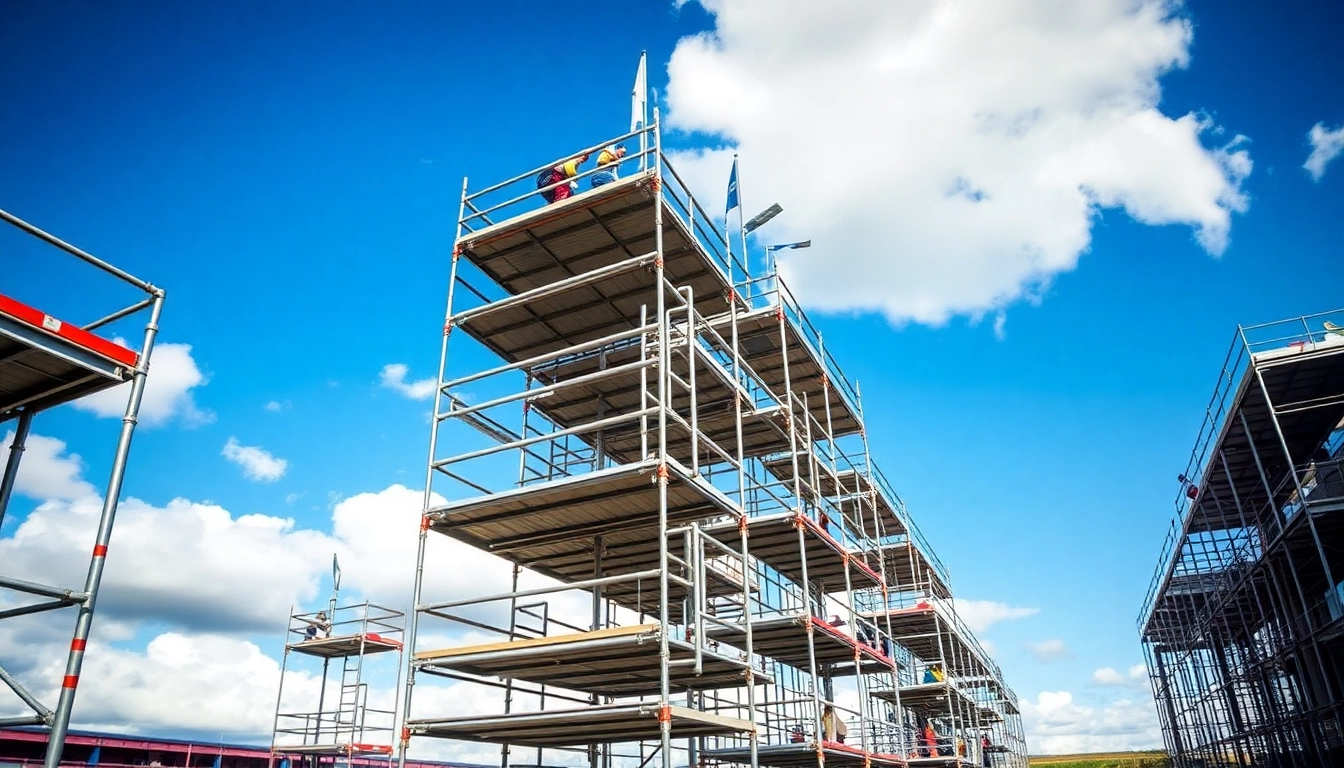Comprehensive Guide to Whangarei Scaffolding Services for Safe Construction
Understanding Whangarei Scaffolding Solutions
Scaffolding is a critical aspect of construction and maintenance projects, providing support and access for workers to perform their tasks safely and efficiently. In Whangarei, the demand for reliable scaffolding solutions has grown alongside the region’s expanding construction industry. Whether you’re engaged in residential renovations, commercial developments, or industrial projects, understanding Whangarei scaffolding is essential for ensuring safety and efficiency on your job site.
What is Whangarei scaffolding?
Whangarei scaffolding refers to the temporary structures used to support a work crew and materials during the construction or maintenance of buildings, bridges, and other projects in the Whangarei area. These structures are designed to provide a safe working environment at various heights, facilitating easier access to difficult-to-reach areas.
Types of scaffolding commonly used
In Whangarei, several types of scaffolding systems are commonly employed, each tailored to specific project needs:
- Frame Scaffolding: This is the most widely used type, consisting of pre-fabricated frames that support horizontal and vertical boards, providing a stable platform for workers and materials.
- System Scaffolding: Composed of lightweight components that can be assembled into various configurations, system scaffolding is ideal for complex structures.
- Suspended Scaffolding: Typically used for high-rise buildings, this scaffolding hangs from the roof and is adjustable in height, allowing workers to reach different levels easily.
- Mobile Scaffolding: These scaffolds are equipped with wheels, allowing for easy relocation on project sites where mobility and flexibility are needed.
- Single Scaffolding: Primarily used in brick masonry work, single scaffolding consists of just one set of standards and is less common for larger projects.
Choosing the right scaffolding for your project
Selecting the appropriate scaffolding system is crucial for the success of your project. Factors to consider include:
- Project Type: Residential projects may require different scaffolding than commercial or industrial projects, which might involve more extensive structures.
- Height Requirements: The height of the construction site directly influences the type of scaffolding needed.
- Load Capacity: Ensure that the chosen scaffolding can safely support the weight of workers, equipment, and materials.
- Site Conditions: Factors such as weather, ground conditions, and nearby structures can affect scaffolding choice and installation.
Key Benefits of Using Whangarei Scaffolding
Enhancing site safety and worker protection
One of the primary advantages of using scaffolding in Whangarei is the improvement in site safety. Scaffolding provides a stable and secure platform that reduces the risk of falls, one of the leading causes of construction injuries. By ensuring that workers have a safe height to operate from, potential accidents can be minimized. Additionally, proper scaffolding setups often include safety features such as guardrails, toeboards, and secure access points to further enhance safety.
Improved access for construction projects
Scaffolding allows workers better access to various parts of a construction site, particularly in spaces that are difficult to reach without assistance. This accessibility enhances productivity, allowing tasks to be completed more efficiently and with fewer delays. Whether workers need to perform tasks on rooftops, high walls, or on various elevated work surfaces, scaffolding provides the necessary support to accomplish the job effectively.
Cost-effectiveness and efficiency in building
Investing in quality scaffolding can be cost-effective in the long run. By providing work teams with safe and efficient access to all areas of a construction site, it minimizes downtime and increases the speed of project completion. Additionally, well-planned scaffolding solutions can help avoid costly accidents and worker injuries, thus saving money associated with insurance claims and project delays.
Compliance and Safety Standards in Whangarei
Understanding local regulations for scaffolding
Compliance with local regulations regarding scaffolding is crucial for any construction project in Whangarei. The local council and construction standards require that specific safety measures and protocols are followed. These include proper design specifications for scaffolding systems, adherence to load limits, and regular inspections. Being aware of and complying with these regulations not only safeguards workers but also helps maintain the integrity of the project.
Importance of using certified scaffolding providers
Selecting certified scaffolding providers in Whangarei is essential for ensuring the safety and quality of the scaffolding system being used. Certified providers follow stringent industry standards and are equipped with the knowledge and expertise to deliver scaffolding solutions that meet local regulations. This ensures that the scaffolding is correctly erected and provides the necessary safety features for workers.
Safety training for workers on scaffolding systems
Proper training for construction workers who use scaffolding is critical. Workers should be well-versed in how to use scaffolding systems safely, including understanding weight limits, access methods, and safety protocols. Providing comprehensive training not only enhances the safety of each individual on-site but also contributes to overall project efficiency.
Choosing a Scaffolding Provider in Whangarei
What to look for in a scaffolding company
When selecting a scaffolding provider in Whangarei, various factors should be considered to ensure that you get the best service and equipment:
- Experience: Look for companies with a solid reputation and years of experience in the scaffolding industry.
- Quality Standards: Ensure that the company follows stringent safety guidelines and uses high-quality materials for its scaffolding systems.
- Comprehensive Services: Providers offering a range of scaffolding solutions, including design, installation, and maintenance, can provide additional convenience and reliability.
- Customer Support: A good scaffolding company will have a responsive customer service team to address any concerns or questions.
Assessing reviews and company reputation
Before deciding on a scaffolding provider, it is crucial to assess customer reviews and the company’s reputation within the Whangarei community. This can be done through online research, referrals, and testimonials. Look for companies with consistently positive feedback related to safety, reliability, and overall service quality.
Getting accurate quotes and service packages
When seeking scaffolding services, it’s helpful to request quotes from multiple providers. Ensure that these quotes are detailed and include all aspects of service, such as delivery, assembly, dismantling, and maintenance. This allows for effective budgeting and helps compare the value of different companies’ offerings.
Managing Your Scaffolding Needs Effectively
Planning scaffolding for different project types
Effective management of scaffolding needs begins with meticulous planning. Different projects will have distinct requirements; therefore, creating a scaffold plan that aligns with the specific demands of each project is essential. Engage with project managers, safety officers, and scaffold specialists to devise a solution that accommodates height requirements, load capacities, and timelines. This proactive approach ensures that scaffolding is adequately integrated into the overall construction plan, facilitating seamless operations.
Maintenance and inspection tips for scaffolding
Routine maintenance and inspections of scaffolding systems are mandatory for keeping them safe and functional. Regular checks should include:
- Assessment of structural integrity and stability.
- Checking for signs of wear and tear, such as rust or damaged components.
- Ensuring that safety features, such as guardrails, remain intact and functional.
- Confirming that the scaffolding remains level and correctly anchored.
By conducting these inspections regularly and addressing any issues promptly, you can ensure worker safety and project efficiency.
Addressing common challenges in scaffolding management
Various challenges can arise during scaffolding management, including scheduling conflicts, safety compliance, and fluctuating site conditions. Developing a clear communication structure among project stakeholders can help manage these challenges effectively. Regular briefings and updates can keep everyone informed of any changes, ensuring that the scaffolding systems remain aligned with project requirements. Additionally, staying adaptable in response to site conditions and having contingency plans in place allows for a swift response to unforeseen events.














Post Comment